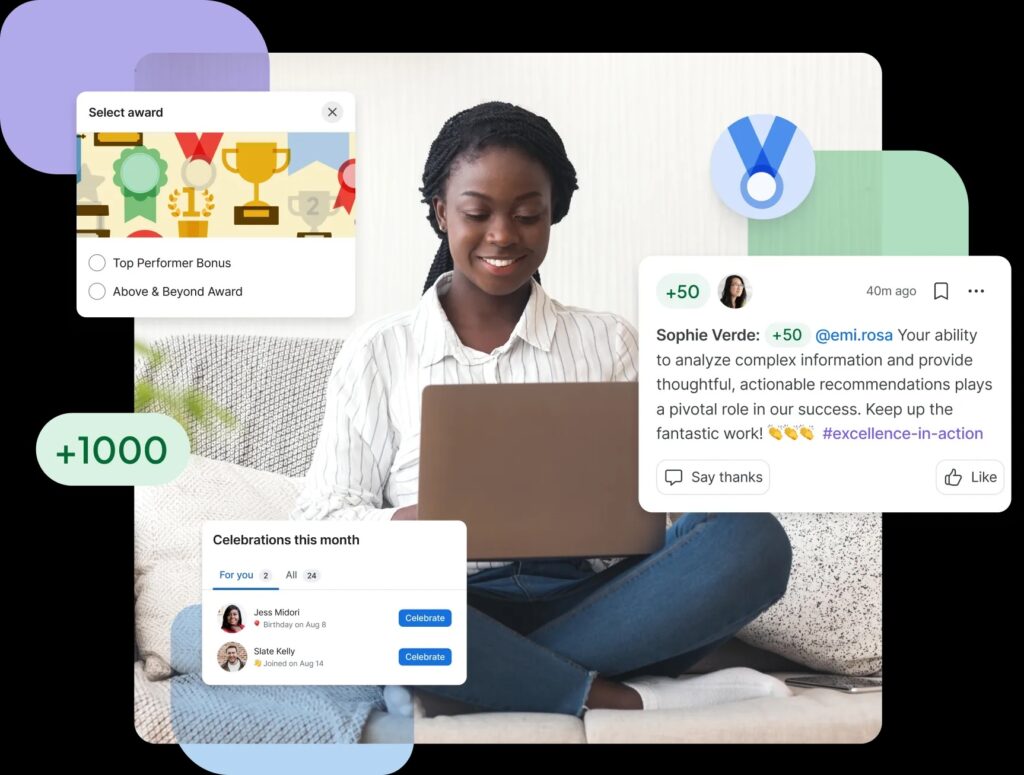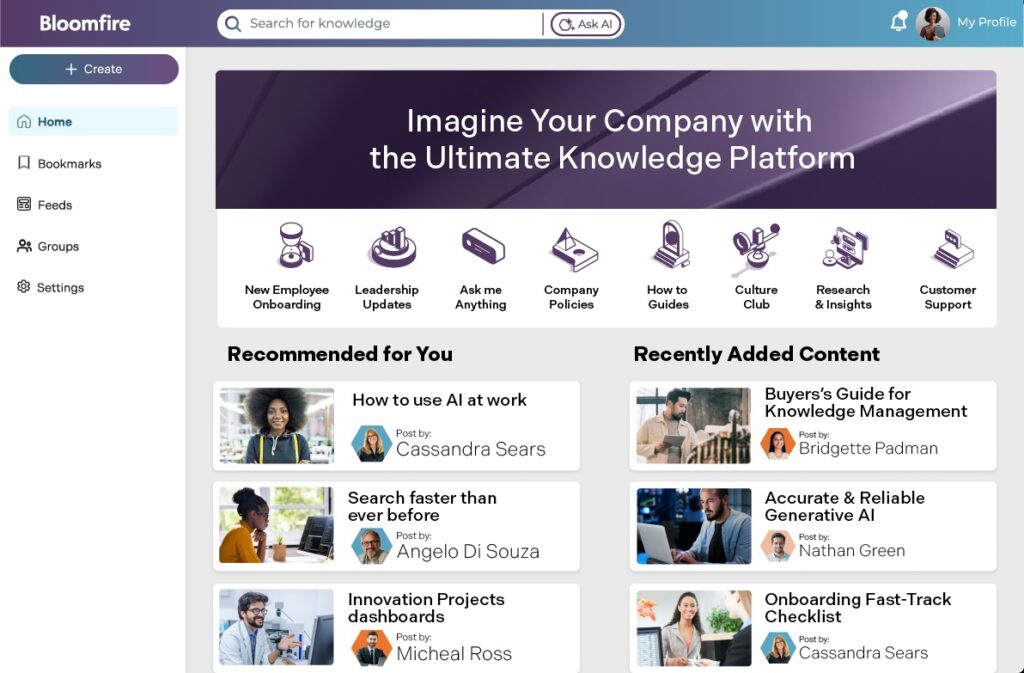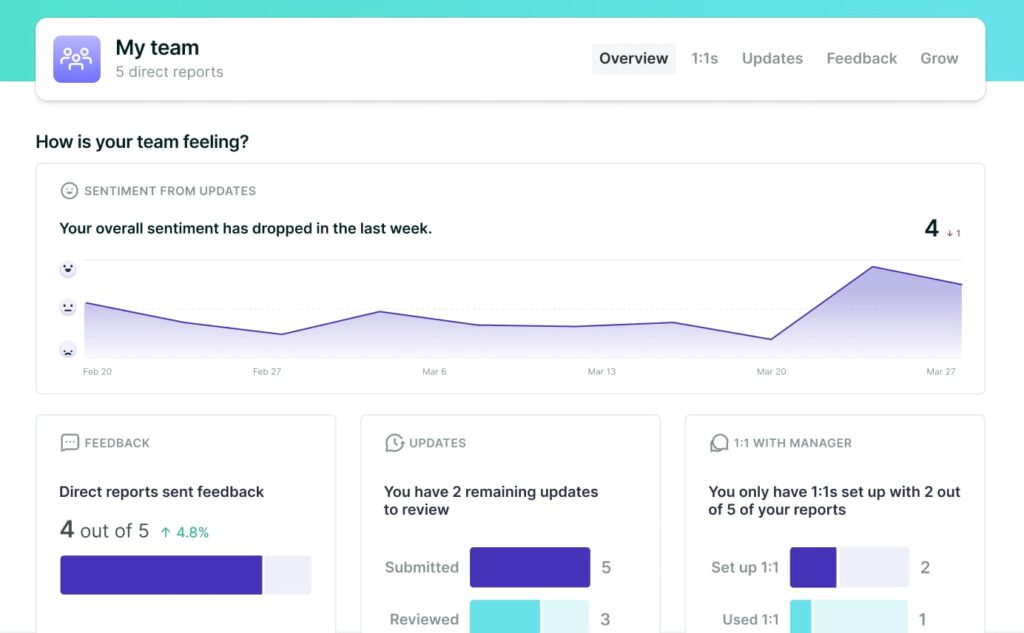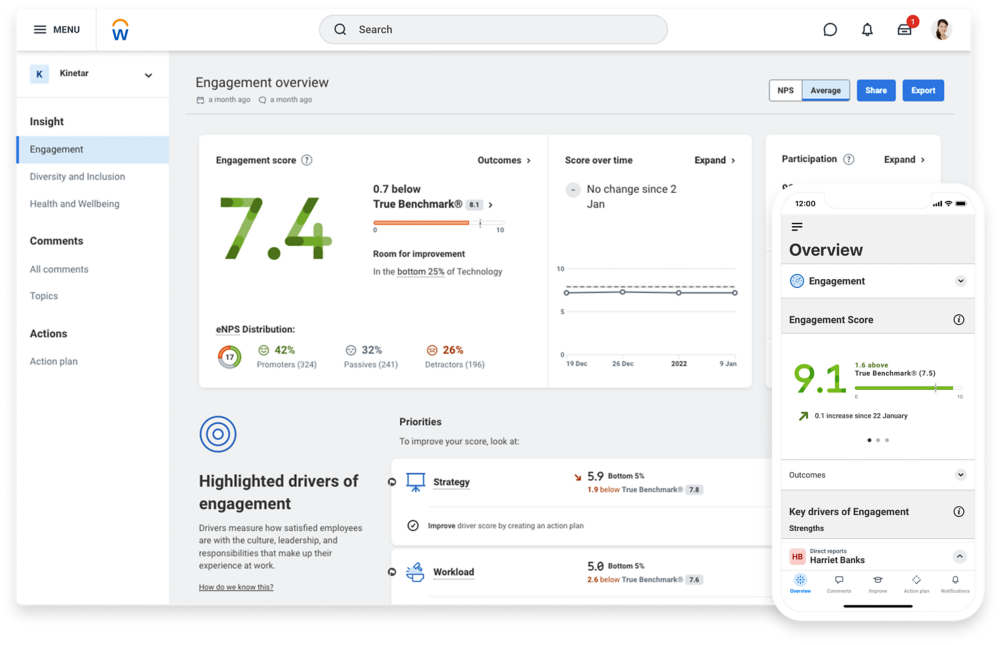Employee experience (EX) is a critical factor that shapes not only employee satisfaction but also overall business success. Consider these compelling statistics:
- 90% of employees believe that their experience as an employee directly impacts the experience they provide to customers.
- 99% of employees say EX affects their productivity, 100% say it affects their mood, and over 98% say it impacts their personal life.
- Organizations with a cross-functional team dedicated to workplace experience strategy are 80% more likely to achieve high employee satisfaction.
This article explores the importance of employee experience and the tools available to enhance it.
What you’ll find in this article:
- Types of employee experience solutions
- List of software vendors for each tool type
- GoProfiles and GoSearch for employee experience
- Choosing the right employee experience solutions
- Implementing employee experience solutions effectively
- FAQs about employee experience
Types of employee experience solutions
Employee engagement platforms
Employee engagement platforms help HR teams and managers engage employees by facilitating communication, recognition, and feedback. These tools are essential for maintaining high engagement levels and a positive company culture.
1. GoProfiles
An AI-powered platform for team analytics, peer recognition, and employee engagement. GoProfiles provides insights into team dynamics, helps in identifying high-performing employees, and fosters a culture of recognition and appreciation. It’s user-friendly and integrates seamlessly with existing workflows, making it a powerful tool for HR leaders.
GoProfiles Features:
✅ Employee profiles
✅ Interactive org chart
✅ Employee directory
✅ Employee map
✅ Team insights and analytics
✅ Employee-first experience
✅ Generative AI-powered
✅ Milestone celebrations
✅ Dynamic peer recognition
✅ Team building game
✅ Automatic employee data syncs with 50+ HRIS apps
✅ iOS mobile app

2. Culture Amp
Employee feedback and analytics platform for improving employee engagement. Culture Amp offers survey tools and data analytics to help HR teams understand and improve the employee experience. It also provides benchmarks to compare performance against industry standards.

3. Bonusly
Peer-to-peer recognition software that enhances company culture and employee satisfaction. Bonusly makes it easy for employees to recognize each other’s contributions, promoting a culture of appreciation and positive reinforcement.

4. Officevibe
Engagement tool that includes pulse surveys and feedback mechanisms. Officevibe helps HR teams and managers track employee engagement and identify areas for improvement through regular, anonymous feedback.

5. 15Five
Provides performance management, including check-ins, objectives, and recognition. 15Five emphasizes regular feedback and goal setting, ensuring that employees feel heard and valued. It also includes features like pulse surveys to gauge employee sentiment regularly.

Knowledge management tools
Knowledge management tools ensure employees have easy access to information, promoting efficiency and reducing frustration. These tools are crucial for employee satisfaction and productivity.
6. GoSearch
An AI-powered enterprise search tool that allows employees to quickly find the information they need. GoSearch offers advanced search capabilities, making it easy for employees to locate documents, files, and information across the organization. This reduces time spent searching for resources and increases productivity.
GoSearch features:
✅ Data indexed in real-time
✅ 100+ integrations (personal and workplace connectors)
✅ AI summaries with semantic understanding
✅ AI assistant chatbot
✅ Multimodal AI
✅ Custom GPTs

7. Confluence
Collaboration and knowledge-sharing tool that helps teams document and share knowledge. Confluence allows teams to create, share, and collaborate on projects in a centralized space, improving knowledge management and team collaboration.

8. Guru
Knowledge management solution that integrates with existing workflows. Guru captures and organizes company knowledge, ensuring that employees have the information they need at their fingertips. It integrates with tools like Slack and Microsoft Teams for knowledge sharing.

9. Bloomfire
Knowledge sharing platform that improves accessibility to company information. Bloomfire provides a searchable, central repository for company knowledge, making it easy for employees to find and share information.

10. Notion
All-in-one workspace for notes, tasks, databases, and collaboration. Notion combines various productivity tools into one platform, allowing teams to manage projects, share knowledge, and collaborate effectively.

Performance management systems
Performance management systems facilitate regular performance reviews, goal setting, and feedback, ensuring that employees feel valued and understand their growth path within the company.
11. Lattice
Performance management tool that includes goals, feedback, and performance reviews. Lattice helps companies manage performance reviews, track employee goals, and gather feedback, creating a culture of continuous improvement and development.

12. BambooHR
HR software that includes performance management and employee feedback features. BambooHR offers a range of HR tools, including performance management, to help companies streamline HR processes and improve employee engagement.

13. Trakstar
Performance appraisal software that helps in setting and tracking goals. Trakstar simplifies the performance review process, allowing managers to set clear goals and track employee progress.

14. ClearCompany
Talent management platform with performance review and goal alignment features. ClearCompany provides tools for performance management, recruitment, and onboarding, helping companies align their talent management strategies with business goals.

15. Betterworks
Performance enablement software that focuses on continuous performance management. Betterworks helps organizations align, develop, and activate their workforce through goal setting, feedback, and check-ins.

Employee feedback tools
Employee feedback tools are designed to gather, analyze, and act on feedback from employees. These tools help HR teams understand employee sentiments and make informed decisions to improve their experience.
16. SurveyMonkey
Customizable survey tool for gathering employee feedback. SurveyMonkey allows companies to create and distribute surveys to gather feedback on various aspects of the employee experience, from engagement to satisfaction.

17. TINYpulse
Pulse survey tool for real-time employee feedback. TINYpulse provides regular, anonymous feedback from employees, helping companies identify issues and make improvements in real-time.

18. Qualtrics
Experience management platform that includes employee feedback solutions. Qualtrics offers comprehensive tools for gathering and analyzing employee feedback, helping companies improve engagement and retention.

19. Peakon
Employee engagement and feedback platform. Peakon provides real-time insights into employee engagement, helping companies understand and act on feedback to improve the employee experience.

20. Glint
Employee feedback platform that helps improve engagement and performance. Glint offers tools for gathering and analyzing employee feedback, providing actionable insights to improve engagement and performance.

Which employee experience solution is right for you?
Selecting employee experience solutions for your organization requires an understanding of your company’s needs, culture, and goals.
Here are some steps to help you choose the best tools for your organization:
- Assess your current employee experience: Start by evaluating your current employee experience. Gather feedback from employees through surveys, interviews, and focus groups to identify pain points and areas for improvement. Understanding your starting point will help you choose solutions that address specific needs.
- Define your goals: Clearly define what you want to achieve with your employee experience solutions. Whether it’s improving engagement levels, streamlining knowledge management, or enhancing performance management, having clear goals will guide your selection process.
- Research and compare solutions: Research different employee experience platforms and tools. Look for solutions that align with your goals and offer features that address your specific needs. Compare vendors based on factors like ease of use, integration capabilities, scalability, and cost.
- Consider employee feedback: Involve employees in the decision-making process. Gather their input on the tools they find most useful and user-friendly. This ensures that the chosen solutions will be well-received and effectively utilized.
- Pilot and evaluate: Before fully implementing a solution, consider running a pilot program with a small group of employees. This allows you to test the tool’s effectiveness and gather feedback for any necessary adjustments.
- Vendor support and training: Make sure that the vendor offers robust support and training resources. Proper training and support are crucial for successful implementation and long-term usage of the tool.
Implementing employee experience solutions
Once you’ve selected the right employee experience solutions, effective implementation is the next big step.
Here are some best practices for a successful implementation:
- Develop a clear implementation plan: Create a detailed plan outlining the steps for implementation. This should include timelines, responsibilities, and milestones to ensure a smooth rollout.
- Communicate with employees: Clearly communicate the purpose and benefits of the new solutions to employees. Address any concerns and provide information on how the tools will enhance their work experience.
- Provide training: Offer comprehensive training sessions for employees to ensure they understand how to use the new tools effectively. Consider different training formats such as workshops, webinars, and one-on-one sessions to accommodate various learning preferences.
- Encourage adoption: Encourage employees to adopt the new solutions by highlighting their benefits and providing ongoing support. Recognize and reward employees who actively use and promote the tools.
- Monitor and adjust: Continuously monitor the usage and effectiveness of the new solutions. Gather feedback from employees and make necessary adjustments to optimize their impact. Regularly review the performance metrics to ensure the solutions are meeting your goals.
- Foster a culture of continuous improvement: Promote a culture of continuous improvement by regularly soliciting feedback and making iterative enhancements to the employee experience. Encourage employees to share their ideas and suggestions for further improvements.
Improve your employee experience
Creating a positive employee experience is essential for maintaining high engagement levels, improving employee retention, and boosting overall productivity.
By leveraging the right employee experience solutions, you can significantly enhance the employee journey, leading to better customer experiences and a stronger company culture.
Enhance your team’s engagement and satisfaction with GoProfiles. This AI-powered platform provides insights, facilitates peer recognition, and helps you build a positive and productive work environment.
Learn more or see GoProfiles in action!
Build a culture of connection and recognition with GoProfiles
Schedule a demo
FAQs
What is employee experience?
Employee experience includes all interactions an employee has with their employer, from recruitment to exit. It encompasses the physical workspace, digital tools, company culture, and overall work environment.
Why is employee experience important?
A positive employee experience leads to higher engagement, retention, productivity, and better customer experiences. Happy employees are more likely to provide exceptional service and contribute to a positive company culture.
What tools can improve employee experience?
Tools for engagement, knowledge management, performance management, and feedback can significantly improve employee experience. These tools help create a supportive work environment where employees feel valued and heard.
How do engagement platforms help?
Engagement platforms facilitate communication, recognition, and feedback, which are crucial for maintaining high engagement levels. They help HR teams and managers keep employees motivated and connected to the company’s goals and values.
What are pulse surveys?
Pulse surveys are quick, frequent surveys that gather real-time feedback from employees. They provide insights into employee sentiment and help identify issues before they become significant problems.
How can knowledge management tools benefit employees?
Knowledge management tools ensure employees have easy access to information, promoting efficiency and reducing frustration. They help employees find the resources they need quickly, improving productivity and satisfaction.
What is the role of HR teams in employee experience?
HR teams implement and manage employee experience platforms and solutions, shaping the overall employee journey. They play a crucial role in creating a positive work environment and addressing employee concerns.
What are some examples of employee engagement platforms?
Examples include GoProfiles, 15Five, Culture Amp, Bonusly, and Officevibe. These platforms offer various features to engage employees, from recognition and feedback to performance management.
How does employee feedback impact company culture?
Regular feedback helps identify areas of improvement, fostering a positive and open company culture. It encourages employees to share their thoughts and feel that their opinions matter.
How can performance management systems improve employee experience?
Performance management systems facilitate regular reviews, goal setting, and feedback, ensuring employees understand their growth path within the company. They help recognize achievements and address development areas, contributing to a more supportive work environment.
What is the impact of employee recognition on engagement levels?
Employee recognition significantly boosts morale and motivation. When employees feel appreciated for their contributions, they are more engaged, more productive, and more committed to the organization.
How can organizations measure the effectiveness of their employee experience solutions?
Organizations can measure effectiveness through regular employee surveys, feedback tools, and performance metrics. Monitoring engagement levels, retention rates, and productivity indicators can provide insights into the impact of employee experience solutions.
What role does company culture play in the employee experience?
Company culture shapes the overall work environment and influences how employees interact with each other and with the organization. A positive, inclusive culture promotes engagement, collaboration, and satisfaction, enhancing the overall employee experience.
Why is it important to involve employees in the selection of employee experience tools?
Involving employees in the selection process ensures the chosen tools meet their needs and preferences, leading to higher adoption rates and effectiveness. Employee input helps identify the most beneficial and user-friendly features, increasing the likelihood of successful implementation.








